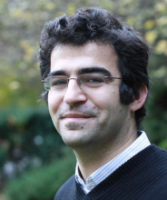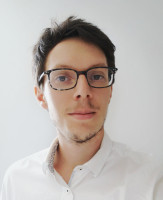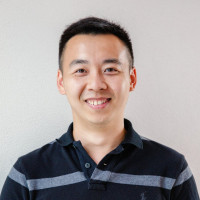Prevention & Personalised Health
Medical Treatment & Drug Development
Diagnosis & Imaging
Biotech- and Nanotechnology
AXA Chairs
France
2012.12.31
AXA-ESPCI Chair in Biomedical Imaging
Renowned for his research into the nature and behavior of wave/matter interactions, Prof. Emmanuel Fort is the newly appointed holder of the AXA-ESPCI Chair in Biomedical Imaging at ParisTech, the Paris Institute of Science and Technology. His lab is searching for ways to use nanotechnologies to make biomedical imaging much more precise than existing methods such as MRI.
Gold nanoparticles have been known for their healing properties since ancient Greece. The odd qualities of these nanoparticles are rich in possibilities for medical research for two reasons. For one, they serve as antennae, which capture and focus waves. Then, they scatter back the energy of these waves in the form of light or convert the absorbed energy into heat. The medical challenge is to exploit these features, especially the strong interaction with light.
Part of Fort’s research uses the unique properties of these nanoparticles to image and destroy cancer tumors. When exposed to a particular wavelength of light, the particles emit light back. This enables a non-invasive, extremely high-definition biopsy, for example. What is more, because the nano-scale emitters can also produce heat, they could conceivably be used to very precisely “bake” cancerous cells, without affecting healthy ones.
Fort’s research also focuses on cellular ultramicroscopy in which live cell activity can be observed with a nanometric resolution and a sensitivity down to a single molecule. Reaching these ultimate detection limits is most challenging but crucial to understanding the mechanisms involved in numerous diseases, such as Alzheimer's. Fort uses innovative principles to specifically improve the axial resolution and obtain 3D images of cells with a nanometer resolution.
Overall, Fort’s goal is to create new types of imagery that marry diagnosis and therapy techniques into a single, unified form of treatment.
Support health 2.0
Hosted at the ESPCI ParisTech's Langevin Institute “Waves & Images”, this Chair in Biomedical Imaging has been awarded to Professor Emmanuel Fort, one of the leading experts in wave-matter interaction. The goal of the Chair is to contribute to a better detection and representation of bodies, vessels and human tissues and to pave the way for less invasive and traumatic surgeries and therapies for patients.
For more information, read this great article, a recap on Professor Emmanuel Fort's presentation by the ParisTech Review.
Will tomorrow's medicine enable us to fight battles against cardiovascular, cancer and neurological diseases from a remote distance?
From detection to diagnosis to treatment, scientific research is constantly looking for new and better tools to improve the quality of care of patients. However, the latter is closely related to the ability of healthcare professionals to visualize organs, human tissue and vessels, the vectors of therapeutic intervention. Advances in biomedical imaging, precisely because they allow for a better representation and detection of tissues and problematic masses in the body will enable less invasive surgeries and traumatic therapies for patients in the future.
The work of Emmanuel Fort, the AXA - ESPCI Chair holder, is at the heart of these issues, at the crossroads of fundamental physics research and technological innovation. A former student at Telecom ParisTech and an École Polytechnique graduate, he was appointed lecturer at the University Paris-Diderot in 2000 and joined the Langevin Institute (winner of the Laboratoire and Équipment d'Excellence awards) at ESPCI ParisTech in 2010. He is interested in imaging techniques and innovative optical sensing techniques for biomedical applications in diagnosis and therapy (from optics to photonics, including ultrasound and fluorescence). Another part of his activities is more fundamental and focuses on the analogies between quantum and classical systems.
Thanks to the AXA Chair endowment, his research will not only help refine diagnostic and therapeutic treatments in vivo, in a non-invasive way, but also develop virtual biopsy operations. In addition, he will study the risks and benefits of the therapeutic use of nanoparticles and is already involved in several national and international collaborations, including with MIT and the University of Singapore.
Beyond the obvious scientific value of Emmanuel Fort's results (fifty scientific papers published as of today), the innovative nature of his research allowed him to file several international patents. Laureate of the 2009 Diderot-Innovation Prize and of the 2012 Jean-Jerphagnon Prize, this young researcher is identified by the international community as one of the up-and-coming scientists of the young generation.
To add or modify information on this page, please contact us at the following address: community.research@axa.com

Emmanuel
FORT
Institution
École Supérieure de Physique et de Chimie Industrielles
ParisTech
Country
France
Nationality
French
Related articles
Pollution
Prevention & Personalised Health
Toxic Pollutants & Hazardous Substances
Plastics
Post-Doctoral Fellowship
Luxembourg
Using New Data Sources to Better Manage Substances of Concern (Soc)
In order to put together an accurate risk management process and drive the appropriate regulatory policies, it is necessary to... Read more

Oona
FREUDENTHAL
Luxembourg Institute of Science and Technology
Prevention & Personalised Health
Pollution
Microbiome
Toxic Pollutants & Hazardous Substances
Post-Doctoral Fellowship
France
2022.07.31
Investigating the Impact of Glyphosate on Health: The Role of Gut Microbiota
Dr. Lauris Evariste aims to investigate the impact of chronic glyphosate exposure on the mouse and human gut microbiota and... Read more

Lauris
EVARISTE
